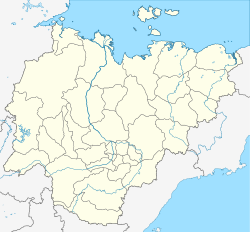Jukagir
settlement
|
||||||||||||||||||||||||
|
||||||||||||||||||||||||
|
||||||||||||||||||||||||
Jukagir ( Russian Юкаги́р; Yakut Дьүкээгир) is a settlement in the north of Ust-Janski ulus in the Republic of Sakha (Yakutia) in the Far East of Russia with 122 inhabitants (as of January 1, 2017). Jukagir is the administrative center and the only settlement point of the Jukagir National (Nomadic) Naslegs .
geography
The place is located on the coast of the Jansk Bay in the Laptev Sea , a marginal sea of the Arctic Ocean . About 8 km north of the settlement, at the foot of Cape Irtyshkin , the river Muksunuocha flows into the sea. Inland from Jukagir are the two lakes Maksunuocha and Sjugetschan . Jukagir is about 276 km as the crow flies from the southern center of Ust-Janski ulus, Deputatski . In addition, it is about 1158 km as the crow flies northeast of the republic capital Yakutsk .
history
On October 5, 1992, the Yukagir National (Nomadic) Nasleg was established by spinning off the Kazachin National Nasleg . Jukagir became the center of the new administrative unit.
In 2002, two students found the head of a mammoth near the settlement on the banks of the Muksunuocha River . The age of the male animal could be determined at about 18,300 years with the help of the radiocarbon method. Due to the well-preserved condition of the head, it became a central exhibit at the World Expo 2005 in Japan .
In 2010, residents of Jukagir discovered an almost completely preserved woolly mammoth on the nearby Laptev Sea beach . The 106 kg young animal was nicknamed "Yuka" by the residents. Researchers found that the animal died around 39,000 years ago, between the ages of 6 and 9. "Yuka" is the first mammoth to be found with a completely intact brain.
In August 2011, about 37 km from the settlement on the shore of Lake Tschuktschalach one about 9,310 years old Bison discovered. This was the first finding of a specimen of this type of horn-beard that had been found with all its limbs and internal organs. The remains of a full-grown mare's body with an established age of around 4,360 years were also discovered near the bison .
Population development
| year | Residents |
|---|---|
| 2002 | 106 |
| 2007 | 127 |
| 2010 | 128 |
| 2012 | 123 |
| 2013 | 122 |
| 2014 | 120 |
| 2015 | 126 |
| 2016 | 123 |
| 2017 | 122 |
| 2018 | 124 |
Note: census data
See also
Individual evidence
- ↑ Population of the Russian Federation by municipality as of January 1, 2017 (in Russian) . Federal State Statistics Service Republic of Sakha. January 1, 2017. Accessed July 17, 2018.
- ↑ The History of the Mammoth Finds in Siberia: The Jukagir Mammoth from 2002 (in Russian) . planetguide.ru. November 21, 2015. Accessed July 17, 2018.
- ↑ Expo in Japan: Future salute from Nagakute . Spiegel Online . March 23, 2005. Retrieved July 17, 2018.
- ↑ The mammoth has arrived in Moscow . Russian Geographical Society . October 28, 2014. Retrieved July 17, 2018.
- ↑ The mammoth Yuka is 39,000 years old . BZ . July 10, 2013. Retrieved July 17, 2018.
- ↑ Woolly Mammoth Mummy Yields Well-Preserved Brain . Live Science. November 7, 2014. Retrieved July 17, 2018.
- ↑ A dead buffalo made friends in the USA and Russia (in Russian) . Gazeta.ru. November 7, 2014. Retrieved July 17, 2018.
- ↑ Complete 9000 Year Old Frozen Bison Mummy Found in Siberia . Society of Vertebrate Paleontology . November 6, 2014. Retrieved July 17, 2018.

